View in other NatureServe Network Field Guides
NatureServe
Montana
Utah
Wyoming
Idaho
Wisconsin
British Columbia
South Carolina
Yukon
California
New York
Dusky Arion - Arion subfuscus
Other Names:
Limax subfuscus, Arion hortensis, Arion fuscus
General Description
A medium to large slug, reaching 70 mm extended, but often smaller. Dorsal base color is brownish-yellow to pale orange, the tentacles dark. The mantle is granulose, about 1/3 the body length, and the same color as the tail, with a lighter region along the margin and an indistinct pair of brown lateral bands. The pneumostome is in the anterior half of the mantle on the right side, posterior to the mantle cleft. The tail has a pair of brownish lateral bands extending to the posterior end, lacks a mid-dorsal keel, and is covered dorsally with many fine tubercles in a series of rows. The sole is pale, undivided (lacking two longitudinal furrows); the mucous is yellowish to orangish-yellow (McDonnell et al. 2009, Hendricks 2012, Burke 2013). Internal anatomy is described by Pilsbry (1948).
Diagnostic Characteristics
Arion lack an elevated visceral hump, possess a mantle about 1/3 the length of the animal with the pneumostome in the anterior half of the mantle, have an undivided foot, lack a dorsal keel on the tail, have a relatively broad tail covered with rows of prominent turbercles and with a caudal mucous pit at the tip where the pedal furrows meet. A. subfuscus differs from other members of the genus by a combination of it's large size, pale to darker orangish color, indistinct bands on sides, lack of mantle speckles, pale yellow sole, and production of yellowish to orange-yellow mucous.
Species Range
Montana Range
Range Descriptions
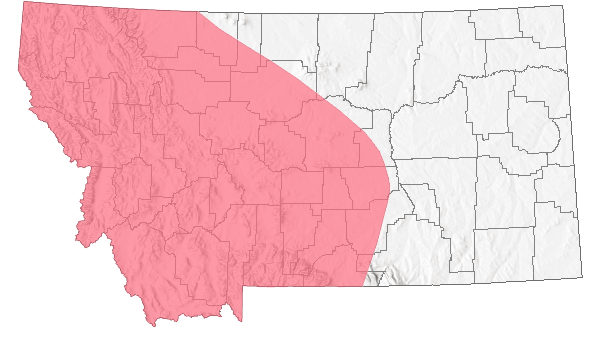
 Non-native
Non-native
Range Comments
Native in Europe; introduced to North America (Burke 2013). In Montana, reported on both sides of the Continental Divide from seven counties, from Glacier National Park (Flathead County) in the northwest to the Boulder River (Sweet Grass County) in the southeast; a Montana report of A. distinctus (Darkface Arion) is probably this species. Elevation range is 1017 to 2004 m (3340 to 6575 ft). Not reported in Montana prior to 2005, but with additional surveys it probably will prove to be one of the most widely distributed species of Arion in areas of human activity and disturbance. As many as 43 individuals were reported at one Gallatin County site in late August, where numerous egg masses were found in rotten wood (Hendricks 2012).
Observations in Montana Natural Heritage Program Database
Number of Observations: 21
(Click on the following maps and charts to see full sized version)
Map Help and Descriptions
Relative Density

Recency
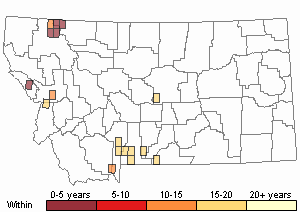
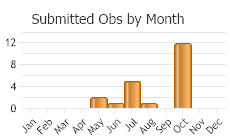
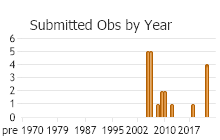
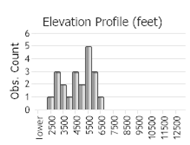 (Observations spanning multiple months or years are excluded from time charts)
(Observations spanning multiple months or years are excluded from time charts)
Habitat
Occupies moist to wet sites (stream-sides, marshy areas, flood plains) within forested or shrubby locations, usually near areas of human activity, such as campgrounds, gardens, and other disturbed sites. Canopy species include Engelmann spruce, Douglas-fir, black cottonwood, aspen, lodgepole pine, ponderosa pine, and grand fir; secondary canopy species include alder, willow, and dogwood. Most often found under woody debris and rocks or in rotten wood (Hendricks 2012).
Reproductive Characteristics
Eggs are globular and a dull yellow color, occurring in clusters of 10-20 (Hendricks 2012).
References
- Literature Cited AboveLegend:
 View Online Publication
View Online Publication Burke, T. E. 2013. Land snails and slugs of the Pacific Northwest. Corvallis, OR: Oregon State University Press. 344 p.
Burke, T. E. 2013. Land snails and slugs of the Pacific Northwest. Corvallis, OR: Oregon State University Press. 344 p. Hendricks, P. 2012. A Guide to the Land Snails and Slugs of Montana. A report to the U.S. Forest Service - Region 1. Montana Natural Heritage Program, Helena, MT. vii + 187 pp. plus appendices.
Hendricks, P. 2012. A Guide to the Land Snails and Slugs of Montana. A report to the U.S. Forest Service - Region 1. Montana Natural Heritage Program, Helena, MT. vii + 187 pp. plus appendices. McDonnell, R. J., T. D. Paine, and M. J. Gormally. 2009. Slugs, a guide to the invasive and native fauna of California. University of California Division of Agriculture and Natural Resources Publication 8336. 21 p.
McDonnell, R. J., T. D. Paine, and M. J. Gormally. 2009. Slugs, a guide to the invasive and native fauna of California. University of California Division of Agriculture and Natural Resources Publication 8336. 21 p. Pilsbry, H.A. 1948. Land Mollusca of North America (north of Mexico), Volume II Part 2. The Academy of Natural Sciences of Philadelphia Monograph Number 2(2): 521-1113.
Pilsbry, H.A. 1948. Land Mollusca of North America (north of Mexico), Volume II Part 2. The Academy of Natural Sciences of Philadelphia Monograph Number 2(2): 521-1113.
- Additional ReferencesLegend:
 View Online Publication
View Online Publication
Do you know of a citation we're missing? Forsyth, R.G. 2004. Land snails of British Columbia. Royal British Columbia Museum: Victoria, British Columbia, Canada. 188 pp.
Forsyth, R.G. 2004. Land snails of British Columbia. Royal British Columbia Museum: Victoria, British Columbia, Canada. 188 pp. Frest, T.J. and E.J. Johannes. 2001. An annotated checklist of Idaho land and freshwater mollusks. Journal of the Idaho Academy of Science 36(2):1-51.
Frest, T.J. and E.J. Johannes. 2001. An annotated checklist of Idaho land and freshwater mollusks. Journal of the Idaho Academy of Science 36(2):1-51. Grimm, F.W., R.G. Forsyth, F.W. Schueler, and A. Karstad. 2009. Identifying land snails and slugs in Canada: introduced species and native genera. Canadian Food Inspection Agency, Ottawa, ON. 168 pp.
Grimm, F.W., R.G. Forsyth, F.W. Schueler, and A. Karstad. 2009. Identifying land snails and slugs in Canada: introduced species and native genera. Canadian Food Inspection Agency, Ottawa, ON. 168 pp.
- Web Search Engines for Articles on "Dusky Arion"
- Additional Sources of Information Related to "Snails / Slugs"





